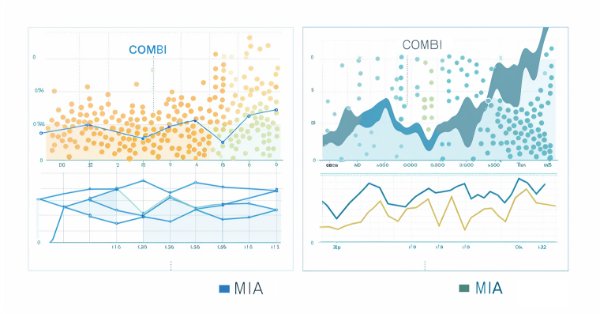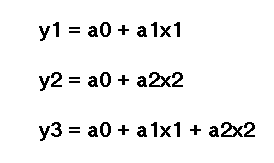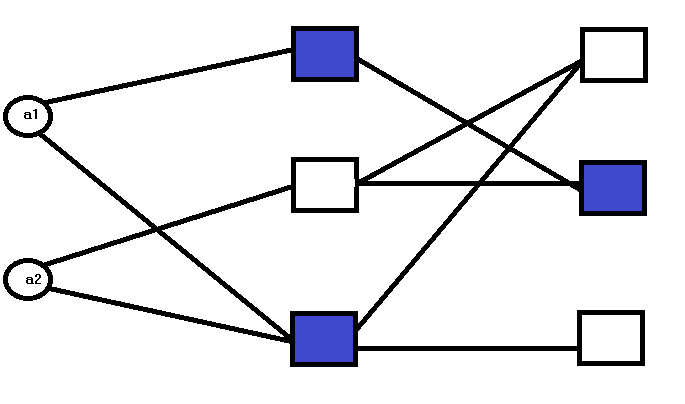
数据处理的分组方法:在MQL5中实现组合算法
概述
GMDH(Group Method of Data Handling)的组合算法,通常被称为COMBI,是GMDH的基本形式,为该系列中更为复杂的算法奠定了基础。与多层迭代算法(MIA)一样,基于一组变量观测值的矩阵形式输入数据样本操作。数据样本被分为两部分:训练样本和测试样本。训练子样本用于评估多项式的系数,而测试子样本则用于根据所选准则的最小值选择最佳模型结构。本文描述了COMBI算法的计算过程。同时,通过扩展前一篇文章中描述的“GmdhModel”类,来展示其在MQL5中的实现。稍后,我们还将讨论与之密切相关的组合选择算法及在MQL5中的实现。最后,我们将通过构建比特币每日价格的预测模型,来总结GMDH算法的实际应用。
COMBI算法
MIA和COMBI算法之间的根本区别在于它们的网络结构不同。与MIA的多层性质相反,COMBI的特点是单层。
这一层的节点数量由输入数量决定。其中,每个节点代表全部输入中的一个或多个已定义的候选模型。为了说明这一点,让我们举一个想要建模的系统实例,该系统由2个输入变量定义。应用COMBI算法,会使用这些变量的所有可能组合来构建候选模型。可能的组合数量由以下公式给出:

其中 :
- m 代表输入变量的数量。
对于这些组合中的每一种组合,都会生成一个候选模型。在第一层和唯一一层的节点处,评估得到的候选模型由下式给出:

其中:
- “a”是系数,“a1”是第一个系数,“a2”是第二个系数。
- “x”是输入变量,“x1”代表第一个输入变量或预测变量,“x2”是第二个。
这个过程涉及解一个线性方程组,以推导出候选模型系数的估值。依据每个模型的性能指标选择最能描述数据的最终模型。
COMBI MQL5实现
基于之前文章中描述的GmdhModel基类实现COMBI算法的代码。它还依赖于在linearmodel.mqh中声明的中间类LinearModel。该类封装了COMBI方法最基本且独特的特征。即COMBI模型完全是线性的。
//+------------------------------------------------------------------+ //| linearmodel.mqh | //| Copyright 2024, MetaQuotes Ltd. | //| https://www.mql5.com | //+------------------------------------------------------------------+ #property copyright "Copyright 2024, MetaQuotes Ltd." #property link "https://www.mql5.com" #include "gmdh.mqh" //+------------------------------------------------------------------+ //| Class implementing the general logic of GMDH linear algorithms | //+------------------------------------------------------------------+ class LinearModel:public GmdhModel { protected: vector calculatePrediction(vector& x) { if(x.Size()<ulong(inputColsNumber)) return vector::Zeros(ulong(inputColsNumber)); matrix modifiedX(1,x.Size()+ 1); modifiedX.Row(x,0); modifiedX[0][x.Size()] = 1.0; vector comb = bestCombinations[0][0].combination(); matrix xx(1,comb.Size()); for(ulong i = 0; i<xx.Cols(); ++i) xx[0][i] = modifiedX[0][ulong(comb[i])]; vector c,b; c = bestCombinations[0][0].bestCoeffs(); b = xx.MatMul(c); return b; } virtual matrix xDataForCombination(matrix& x, vector& comb) override { matrix out(x.Rows(), comb.Size()); for(ulong i = 0; i<out.Cols(); i++) out.Col(x.Col(int(comb[i])),i); return out; } virtual string getPolynomialPrefix(int levelIndex, int combIndex) override { return "y="; } virtual string getPolynomialVariable(int levelIndex, int coeffIndex, int coeffsNumber, vector& bestColsIndexes) override { return ((coeffIndex != coeffsNumber - 1) ? "x" + string(int(bestColsIndexes[coeffIndex]) + 1) : ""); } public: LinearModel(void) { } vector predict(vector& x, int lags) override { if(lags <= 0) { Print(__FUNCTION__," lags value must be a positive integer"); return vector::Zeros(1); } if(!training_complete) { Print(__FUNCTION__," model was not successfully trained"); return vector::Zeros(1); } vector expandedX = vector::Zeros(x.Size() + ulong(lags)); for(ulong i = 0; i<x.Size(); i++) expandedX[i]=x[i]; for(int i = 0; i < lags; ++i) { vector vect(x.Size(),slice,expandedX,ulong(i),x.Size()+ulong(i)-1); vector res = calculatePrediction(vect); expandedX[x.Size() + i] = res[0]; } vector vect(ulong(lags),slice,expandedX,x.Size()); return vect; } }; //+------------------------------------------------------------------+
combi.mqh文件包含COMBI类的定义。该类继承自LinearModel,并定义了用于拟合模型的fit()方法。
//+------------------------------------------------------------------+ //| combi.mqh | //| Copyright 2024, MetaQuotes Ltd. | //| https://www.mql5.com | //+------------------------------------------------------------------+ #property copyright "Copyright 2024, MetaQuotes Ltd." #property link "https://www.mql5.com" #include "linearmodel.mqh" //+------------------------------------------------------------------+ //| Class implementing combinatorial COMBI algorithm | //+------------------------------------------------------------------+ class COMBI:public LinearModel { private: Combination getBest(CVector &combinations) { double proxys[]; int best[]; ArrayResize(best,combinations.size()); ArrayResize(proxys,combinations.size()); for(int k = 0; k<combinations.size(); k++) { best[k]=k; proxys[k]=combinations[k].evaluation(); } MathQuickSortAscending(proxys,best,0,int(proxys.Size()-1)); return combinations[best[0]]; } protected: virtual void removeExtraCombinations(void) override { CVector2d realBestCombinations; CVector n; Combination top; for(int i = 0 ; i<bestCombinations.size(); i++) { top = getBest(bestCombinations[i]); n.push_back(top); } top = getBest(n); CVector sorted; sorted.push_back(top); realBestCombinations.push_back(sorted); bestCombinations = realBestCombinations; } virtual bool preparations(SplittedData &data, CVector &_bestCombinations) override { lastLevelEvaluation = DBL_MAX; return (bestCombinations.push_back(_bestCombinations) && ulong(level+1) < data.xTrain.Cols()); } void generateCombinations(int n_cols,vector &out[]) override { GmdhModel::nChooseK(n_cols,level,out); return; } public: COMBI(void):LinearModel() { modelName = "COMBI"; } bool fit(vector &time_series,int lags,double testsize=0.5,CriterionType criterion=stab) { if(lags < 1) { Print(__FUNCTION__," lags must be >= 1"); return false; } PairMVXd transformed = timeSeriesTransformation(time_series,lags); SplittedData splited = splitData(transformed.first,transformed.second,testsize); Criterion criter(criterion); int pAverage = 1; double limit = 0; int kBest = pAverage; if(validateInputData(testsize, pAverage, limit, kBest)) return false; return GmdhModel::gmdhFit(splited.xTrain, splited.yTrain, criter, kBest, testsize, pAverage, limit); } bool fit(matrix &vars,vector &targets,double testsize=0.5,CriterionType criterion=stab) { if(vars.Cols() < 1) { Print(__FUNCTION__," columns in vars must be >= 1"); return false; } if(vars.Rows() != targets.Size()) { Print(__FUNCTION__, " vars dimensions donot correspond with targets"); return false; } SplittedData splited = splitData(vars,targets,testsize); Criterion criter(criterion); int pAverage = 1; double limit = 0; int kBest = pAverage; if(validateInputData(testsize, pAverage, limit, kBest)) return false; return GmdhModel::gmdhFit(splited.xTrain, splited.yTrain, criter, kBest, testsize, pAverage, limit); } }; //+------------------------------------------------------------------+
使用COMBI类
使用COMBI类将模型拟合到数据集,与使用MIA类的方式是完全相同的。我们需要创建一个实例,并调用其中一个fit()方法。该实例通过脚本COMBI_test.mq5和COMBI_Multivariable_test.mq5来演示。
//+------------------------------------------------------------------+ //| COMBI_test.mq5 | //| Copyright 2024, MetaQuotes Ltd. | //| https://www.mql5.com | //+------------------------------------------------------------------+ #property copyright "Copyright 2024, MetaQuotes Ltd." #property link "https://www.mql5.com" #property version "1.00" #property script_show_inputs #include <GMDH\combi.mqh> input int NumLags = 2; input int NumPredictions = 6; input CriterionType critType = stab; input double DataSplitSize = 0.33; //+------------------------------------------------------------------+ //| Script program start function | //+------------------------------------------------------------------+ void OnStart() { //--- vector tms = {1,2,3,4,5,6,7,8,9,10,11,12}; if(NumPredictions<1) { Alert("Invalid setting for NumPredictions, has to be larger than 0"); return; } COMBI combi; if(!combi.fit(tms,NumLags,DataSplitSize,critType)) return; string modelname = combi.getModelName()+"_"+EnumToString(critType)+"_"+string(DataSplitSize); combi.save(modelname+".json"); vector in(ulong(NumLags),slice,tms,tms.Size()-ulong(NumLags)); vector out = combi.predict(in,NumPredictions); Print(modelname, " predictions ", out); Print(combi.getBestPolynomial()); } //+------------------------------------------------------------------+
两者都使用的相同数据集将COMBI算法应用于示例脚本中,演示如何应用前一篇文章中的MIA算法。
//+------------------------------------------------------------------+ //| COMBI_Multivariable_test.mq5 | //| Copyright 2024, MetaQuotes Ltd. | //| https://www.mql5.com | //+------------------------------------------------------------------+ #property copyright "Copyright 2024, MetaQuotes Ltd." #property link "https://www.mql5.com" #property version "1.00" #property script_show_inputs #include <GMDH\combi.mqh> input CriterionType critType = stab; input double DataSplitSize = 0.33; //+------------------------------------------------------------------+ //| Script program start function | //+------------------------------------------------------------------+ void OnStart() { //--- matrix independent = {{1,2,3},{3,2,1},{1,4,2},{1,1,3},{5,3,1},{3,1,9}}; vector dependent = {6,6,7,5,9,13}; COMBI combi; if(!combi.fit(independent,dependent,DataSplitSize,critType)) return; string modelname = combi.getModelName()+"_"+EnumToString(critType)+"_"+string(DataSplitSize)+"_multivars"; combi.save(modelname+".json"); matrix unseen = {{8,6,4},{1,5,3},{9,-5,3}}; for(ulong row = 0; row<unseen.Rows(); row++) { vector in = unseen.Row(row); Print("inputs ", in, " prediction ", combi.predict(in,1)); } Print(combi.getBestPolynomial()); } //+------------------------------------------------------------------+
通过查看COMBI_test.mq5的输出,我们可以比较拟合多项式的复杂度与MIA算法生成多项式的复杂度。以下是时间序列数据集和多变量数据集分别对应的多项式。
LR 0 14:54:15.354 COMBI_test (BTCUSD,D1) COMBI_stab_0.33 predictions [13,14,15,16,17,18.00000000000001] PN 0 14:54:15.355 COMBI_test (BTCUSD,D1) y= 1.000000e+00*x1 + 2.000000e+00 CI 0 14:54:29.864 COMBI_Multivariable_test (BTCUSD,D1) inputs [8,6,4] prediction [18.00000000000001] QD 0 14:54:29.864 COMBI_Multivariable_test (BTCUSD,D1) inputs [1,5,3] prediction [9] QQ 0 14:54:29.864 COMBI_Multivariable_test (BTCUSD,D1) inputs [9,-5,3] prediction [7.00000000000001] MM 0 14:54:29.864 COMBI_Multivariable_test (BTCUSD,D1) y= 1.000000e+00*x1 + 1.000000e+00*x2 + 1.000000e+00*x3 - 7.330836e-15
接下来是使用MIA方法生成的多项式。
JQ 0 14:43:07.969 MIA_Test (Step Index 500,M1) MIA_stab_0.33_1_0.0 predictions [13.00000000000001,14.00000000000002,15.00000000000004,16.00000000000005,17.0000000000001,18.0000000000001] IP 0 14:43:07.969 MIA_Test (Step Index 500,M1) y = - 9.340179e-01*x1 + 1.934018e+00*x2 + 3.865363e-16*x1*x2 + 1.065982e+00 II 0 14:52:59.698 MIA_Multivariable_test (BTCUSD,D1) inputs [1,2,4] prediction [6.999999999999998] CF 0 14:52:59.698 MIA_Multivariable_test (BTCUSD,D1) inputs [1,5,3] prediction [8.999999999999998] JR 0 14:52:59.698 MIA_Multivariable_test (BTCUSD,D1) inputs [9,1,3] prediction [13.00000000000001] NP 0 14:52:59.698 MIA_Multivariable_test (BTCUSD,D1) f1_1 = 1.071429e-01*x1 + 6.428571e-01*x2 + 4.392857e+00 LR 0 14:52:59.698 MIA_Multivariable_test (BTCUSD,D1) f1_2 = 6.086957e-01*x2 - 8.695652e-02*x3 + 4.826087e+00 ME 0 14:52:59.698 MIA_Multivariable_test (BTCUSD,D1) f1_3 = - 1.250000e+00*x1 - 1.500000e+00*x3 + 1.125000e+01 DJ 0 14:52:59.698 MIA_Multivariable_test (BTCUSD,D1) IP 0 14:52:59.698 MIA_Multivariable_test (BTCUSD,D1) f2_1 = 1.555556e+00*f1_1 - 6.666667e-01*f1_3 + 6.666667e-01 ER 0 14:52:59.698 MIA_Multivariable_test (BTCUSD,D1) f2_2 = 1.620805e+00*f1_2 - 7.382550e-01*f1_3 + 7.046980e-01 ES 0 14:52:59.698 MIA_Multivariable_test (BTCUSD,D1) f2_3 = 3.019608e+00*f1_1 - 2.029412e+00*f1_2 + 5.882353e-02 NH 0 14:52:59.698 MIA_Multivariable_test (BTCUSD,D1) CN 0 14:52:59.698 MIA_Multivariable_test (BTCUSD,D1) f3_1 = 1.000000e+00*f2_1 - 3.731079e-15*f2_3 + 1.155175e-14 GP 0 14:52:59.698 MIA_Multivariable_test (BTCUSD,D1) f3_2 = 8.342665e-01*f2_2 + 1.713326e-01*f2_3 - 3.359462e-02 DO 0 14:52:59.698 MIA_Multivariable_test (BTCUSD,D1) OG 0 14:52:59.698 MIA_Multivariable_test (BTCUSD,D1) y = 1.000000e+00*f3_1 + 3.122149e-16*f3_2 - 1.899249e-15
MIA模型相对复杂,而COMBI模型则较为简单,很像序列本身。反映了该方法的线性特性。这一点也从脚本COMBI_Multivariable_test.mq5的输出中得到了证实,该脚本试图通过提供输入变量和相应的输出示例,来构建一个为三个数字求和的模型。在这里,COMBI算法成功地推断出系统的潜在特性。
COMBI算法的穷举搜索既是一个优势,也是一个劣势。从其积极的一面来看,评估所有输入组合可以确保找到描述数据的最佳多项式。然而,如果输入变量众多,这种广泛的搜索可能令计算成本变得高昂。可能导致训练时间过长。请注意,候选模型的数量由2的m次方减1给出,m越大,需要评估的候选模型数量就越多。为了解决这个问题,又开发了组合选择算法(Combinatorial Selective Algorithm)。
组合选择算法
我们称之为MULTI的组合选择算法,是对COMBI方法在效率方面所做的一种改进。它通过采用类似于GMDH多层算法中使用的程序,避免了穷举搜索。因此,它可以被视为是对原本单层性质的COMBI算法采取的一种多层解决方法。

在第一层中,会估算所有包含一个输入变量的模型,并根据外部标准选择最佳模型,将其传递到下一层。在后续层中,会选择不同的输入变量并添加到这些候选模型中,期待对它们进行改进。是否添加新层取决于输出的准确性是否有所提高,以及是否有可用输入变量,尽管这些变量尚未成为候选模型的一部分。这意味着可能层的最大数量与输入变量的总数相符。
以这种方式评估候选模型通常可以避免穷举搜索,但也导致了一个问题。算法可能无法找到最能描述数据集的最优多项式。这表明在训练阶段应该考虑更多的候选模型。推导出最优多项式成为了一个需要精细化调整众多参数的过程。特别是每层评估的候选模型数量。
组合选择算法的实现
multi.mqh中提供了组合选择算法的实现方式。它包含继承自LinearModel的MULTI类的定义。
//+------------------------------------------------------------------+ //| multi.mqh | //| Copyright 2024, MetaQuotes Ltd. | //| https://www.mql5.com | //+------------------------------------------------------------------+ #property copyright "Copyright 2024, MetaQuotes Ltd." #property link "https://www.mql5.com" #include "linearmodel.mqh" //+------------------------------------------------------------------+ //| Class implementing combinatorial selection MULTI algorithm | //+------------------------------------------------------------------+ class MULTI : public LinearModel { protected: virtual void removeExtraCombinations(void) override { CVector2d realBestCombinations; CVector n; n.push_back(bestCombinations[0][0]); realBestCombinations.push_back(n); bestCombinations = realBestCombinations; } virtual bool preparations(SplittedData &data, CVector &_bestCombinations) override { return (bestCombinations.setAt(0,_bestCombinations) && ulong(level+1) < data.xTrain.Cols()); } void generateCombinations(int n_cols,vector &out[]) override { if(level == 1) { nChooseK(n_cols,level,out); return; } for(int i = 0; i<bestCombinations[0].size(); i++) { for(int z = 0; z<n_cols; z++) { vector comb = bestCombinations[0][i].combination(); double array[]; vecToArray(comb,array); int found = ArrayBsearch(array,double(z)); if(int(array[found])!=z) { array.Push(double(z)); ArraySort(array); comb.Assign(array); ulong dif = 1; for(uint row = 0; row<out.Size(); row++) { dif = comb.Compare(out[row],1e0); if(!dif) break; } if(dif) { ArrayResize(out,out.Size()+1,100); out[out.Size()-1] = comb; } } } } } public: MULTI(void):LinearModel() { CVector members; bestCombinations.push_back(members); modelName = "MULTI"; } bool fit(vector &time_series,int lags,double testsize=0.5,CriterionType criterion=stab,int kBest = 3,int pAverage = 1,double limit = 0.0) { if(lags < 1) { Print(__FUNCTION__," lags must be >= 1"); return false; } PairMVXd transformed = timeSeriesTransformation(time_series,lags); SplittedData splited = splitData(transformed.first,transformed.second,testsize); Criterion criter(criterion); if(validateInputData(testsize, pAverage, limit, kBest)) return false; return GmdhModel::gmdhFit(splited.xTrain, splited.yTrain, criter, kBest, testsize, pAverage, limit); } bool fit(matrix &vars,vector &targets,double testsize=0.5,CriterionType criterion=stab,int kBest = 3,int pAverage = 1,double limit = 0.0) { if(vars.Cols() < 1) { Print(__FUNCTION__," columns in vars must be >= 1"); return false; } if(vars.Rows() != targets.Size()) { Print(__FUNCTION__, " vars dimensions donot correspond with targets"); return false; } SplittedData splited = splitData(vars,targets,testsize); Criterion criter(criterion); if(validateInputData(testsize, pAverage, limit, kBest)) return false; return GmdhModel::gmdhFit(splited.xTrain, splited.yTrain, criter, kBest, testsize, pAverage, limit); } }; //+------------------------------------------------------------------+
MULTI类的工作方式与熟悉的COMBI类及其“fit()”方法类似。与COMBI类相比,读者应注意“fit()”方法中包含了更多的超参数。在应用MULTI类时,“kBest”和“pAverage”是两个可能需要仔细调整的参数。在MULTI_test.mq5和MULTI_Multivariable_test.mq5脚本中展示了将模型拟合到数据集的过程。以下是相关代码。
//+----------------------------------------------------------------------+ //| MULTI_test.mq5 | //| Copyright 2024, MetaQuotes Ltd. | //| https://www.mql5.com | //+----------------------------------------------------------------------+ #property copyright "Copyright 2024, MetaQuotes Ltd." #property link "https://www.mql5.com" #property version "1.00" #property script_show_inputs #include <GMDH\multi.mqh> input int NumLags = 2; input int NumPredictions = 6; input CriterionType critType = stab; input int Average = 1; input int NumBest = 3; input double DataSplitSize = 0.33; input double critLimit = 0; //+------------------------------------------------------------------+ //| Script program start function | //+------------------------------------------------------------------+ void OnStart() { //--- vector tms = {1,2,3,4,5,6,7,8,9,10,11,12}; if(NumPredictions<1) { Alert("Invalid setting for NumPredictions, has to be larger than 0"); return; } MULTI multi; if(!multi.fit(tms,NumLags,DataSplitSize,critType,NumBest,Average,critLimit)) return; vector in(ulong(NumLags),slice,tms,tms.Size()-ulong(NumLags)); vector out = multi.predict(in,NumPredictions); Print(" predictions ", out); Print(multi.getBestPolynomial()); } //+------------------------------------------------------------------+
//+------------------------------------------------------------------+ //| MULTI_Mulitivariable_test.mq5 | //| Copyright 2024, MetaQuotes Ltd. | //| https://www.mql5.com | //+------------------------------------------------------------------+ #property copyright "Copyright 2024, MetaQuotes Ltd." #property link "https://www.mql5.com" #property version "1.00" #property script_show_inputs #include <GMDH\multi.mqh> input CriterionType critType = stab; input double DataSplitSize = 0.33; input int Average = 1; input int NumBest = 3; input double critLimit = 0; //+------------------------------------------------------------------+ //| Script program start function | //+------------------------------------------------------------------+ void OnStart() { //--- matrix independent = {{1,2,3},{3,2,1},{1,4,2},{1,1,3},{5,3,1},{3,1,9}}; vector dependent = {6,6,7,5,9,13}; MULTI multi; if(!multi.fit(independent,dependent,DataSplitSize,critType,NumBest,Average,critLimit)) return; matrix unseen = {{1,2,4},{1,5,3},{9,1,3}}; for(ulong row = 0; row<unseen.Rows(); row++) { vector in = unseen.Row(row); Print("inputs ", in, " prediction ", multi.predict(in,1)); } Print(multi.getBestPolynomial()); } //+------------------------------------------------------------------+
由此可见,通过运行脚本,从我们的简单数据集中得到的多项式与应用COMBI算法得到的多项式完全相同。
IG 0 18:24:28.811 MULTI_Mulitivariable_test (BTCUSD,D1) inputs [1,2,4] prediction [7.000000000000002] HI 0 18:24:28.812 MULTI_Mulitivariable_test (BTCUSD,D1) inputs [1,5,3] prediction [9] NO 0 18:24:28.812 MULTI_Mulitivariable_test (BTCUSD,D1) inputs [9,1,3] prediction [13.00000000000001] PP 0 18:24:28.812 MULTI_Mulitivariable_test (BTCUSD,D1) y= 1.000000e+00*x1 + 1.000000e+00*x2 + 1.000000e+00*x3 - 7.330836e-15 DP 0 18:25:04.454 MULTI_test (BTCUSD,D1) predictions [13,14,15,16,17,18.00000000000001] MH 0 18:25:04.454 MULTI_test (BTCUSD,D1) y= 1.000000e+00*x1 + 2.000000e+00
基于比特币价格的GMDH模型
在本节中,我们将应用GMDH方法来构建比特币每日收盘价预测模型。这将通过文章末尾附带的GMDH_Price_Model.mq5脚本来实现。尽管我们的演示专门针对比特币这一交易品种,但该脚本也可以应用于任何交易品种和时间周期。该脚本具有多个用户可变参数,用于控制程序的各个方面。
//--- input parameters input string SetSymbol=""; input ENUM_GMDH_MODEL modelType = Combi; input datetime TrainingSampleStartDate=D'2019.12.31'; input datetime TrainingSampleStopDate=D'2022.12.31'; input datetime TestSampleStartDate = D'2023.01.01'; input datetime TestSampleStopDate = D'2023.12.31'; input ENUM_TIMEFRAMES tf=PERIOD_D1; //time frame input int Numlags = 3; input CriterionType critType = stab; input PolynomialType polyType = linear_cov; input int Average = 10; input int NumBest = 10; input double DataSplitSize = 0.2; input double critLimit = 0; input ulong NumTestSamplesPlot = 20;
通过下表列出并加以描述。
| 输入参数名称 | 说明 |
|---|---|
| SetSymbol | 设置将用作训练数据收盘价的符号名称,如果留空,则假定应用脚本的图表符号。 |
| modeltype | 它代表由GMDH算法选择的枚举 |
| TrainingSampleStartDate | 样品期内收盘价的起始日期 |
| TrainingSampleStopDate | 样本期内收盘价的结束日期 |
| TestSampleStartDate | 样品期外的开始日期 |
| TestSampleStopDate | 样品期外的结束日期 |
| tf | 应用的时间周期 |
| Numlags | 定义用于预测下一个收盘价的历史滞后值的数量 |
| critType | 指定模型构建过程的外部标准 |
| polyType | 当选择MIA算法时,通过所使用的多项式类型在现有变量的基础上构造新的变量,这在训练过程中非常关键 |
| Average | 在计算停止标准时所要考虑的最优模型数量 |
| Numbest | 对于MIA模型,它定义了最优模型的数量,基于这些模型构建后续层的新输入 而对于COMBI模型,它是在每一层选择候选模型的数量,以供后续迭代时参考 |
| DataSplitSize | 用于评估模型的一部分输入数据 |
| critLimit | 为了继续训练模型,外部标准必须改善一个特定的最小值 |
| NumTestSamplePlot | 该值定义了样本外数据集中可视化的样本数量,以及与这些样本相对应的预测结果 |
该脚本首先从选择一个合适的观测样本作为训练数据开始。
//+------------------------------------------------------------------+ //| Script program start function | //+------------------------------------------------------------------+ void OnStart() { //get relative shift of IS and OOS sets int trainstart,trainstop, teststart, teststop; trainstart=iBarShift(SetSymbol!=""?SetSymbol:NULL,tf,TrainingSampleStartDate); trainstop=iBarShift(SetSymbol!=""?SetSymbol:NULL,tf,TrainingSampleStopDate); teststart=iBarShift(SetSymbol!=""?SetSymbol:NULL,tf,TestSampleStartDate); teststop=iBarShift(SetSymbol!=""?SetSymbol:NULL,tf,TestSampleStopDate); //check for errors from ibarshift calls if(trainstart<0 || trainstop<0 || teststart<0 || teststop<0) { Print(ErrorDescription(GetLastError())); return; } //---set the size of the sample sets size_observations=(trainstart - trainstop) + 1 ; size_outsample = (teststart - teststop) + 1; //---check for input errors if(size_observations <= 0 || size_outsample<=0) { Print("Invalid inputs "); return; } //---download insample prices for training int try = 10; while(!prices.CopyRates(SetSymbol,tf,COPY_RATES_CLOSE,TrainingSampleStartDate,TrainingSampleStopDate) && try) { try --; if(!try) { Print("error copying to prices ",GetLastError()); return; } Sleep(5000);
另一组收盘价样本已被下载,用其绘制预测收盘价和实际收盘价的图表来可视化模型的性能。
//---download out of sample prices testing try = 10; while(!testprices.CopyRates(SetSymbol,tf,COPY_RATES_CLOSE|COPY_RATES_TIME|COPY_RATES_VERTICAL,TestSampleStartDate,TestSampleStopDate) && try) { try --; if(!try) { Print("error copying to testprices ",GetLastError()); return; } Sleep(5000); }
该脚本的用户定义参数能够应用我们之前讨论和实现过的三种GMDH模型之一。
//--- train and make predictions switch(modelType) { case Combi: { COMBI combi; if(!combi.fit(prices,Numlags,DataSplitSize,critType)) return; Print("Model ", combi.getBestPolynomial()); MakePredictions(combi,testprices.Col(0),predictions); } break; case Mia: { MIA mia; if(!mia.fit(prices,Numlags,DataSplitSize,polyType,critType,NumBest,Average,critLimit)) return; Print("Model ", mia.getBestPolynomial()); MakePredictions(mia,testprices.Col(0),predictions); } break; case Multi: { MULTI multi; if(!multi.fit(prices,Numlags,DataSplitSize,critType,NumBest,Average,critLimit)) return; Print("Model ", multi.getBestPolynomial()); MakePredictions(multi,testprices.Col(0),predictions); } break; default: Print("Invalid GMDH model type "); return; } //---
以显示预测收盘价与实际样本期外数据集值的图表作为程序结收尾。
//--- ulong TestSamplesPlot = (NumTestSamplesPlot>0)?NumTestSamplesPlot:20; //--- if(NumTestSamplesPlot>=testprices.Rows()) TestSamplesPlot = testprices.Rows()-Numlags; //--- vector testsample(100,slice,testprices.Col(0),Numlags,Numlags+TestSamplesPlot-1); vector testpredictions(100,slice,predictions,0,TestSamplesPlot-1); vector dates(100,slice,testprices.Col(1),Numlags,Numlags+TestSamplesPlot-1); //--- //Print(testpredictions.Size(), ":", testsample.Size()); //--- double y[], y_hat[]; //--- if(vecToArray(testpredictions,y_hat) && vecToArray(testsample,y) && vecToArray(dates,xaxis)) { PlotPrices(y_hat,y); } //--- ChartRedraw(); }
以下是分别使用组合算法和多层迭代算法进行预测所得的图表。
结论
综上所述,GMDH的组合算法为复杂系统的建模提供了一个框架,特别是在数据驱动、归纳方法领域表现出明显优势。然而,由于该算法在处理大型数据集时效率低下,其实际应用往往受到限制。组合选择算法仅在一定程度上缓解了这一缺陷。在算法中引入更多需要调整的参数,虽然可以带来速度上的提升,但也会增加调优的负担,从而影响到算法性能的发挥。GMDH方法在金融时间序列分析中的应用,显示了其可提供的有价值的潜力。
| File | 说明 |
|---|---|
| Mql5\include\VectorMatrixTools.mqh | 定义函数的头文件,用于操作向量和矩阵 |
| Mql5\include\JAson.mqh | 包含用于解析和生成JSON对象的自定义类型 |
| Mql5\include\GMDH\gmdh_internal.mqh | 包含gmdh库中使用的自定义类型的头文件 |
| Mql5\include\GMDH\gmdh.mqh | 包含定义基类GmdhModel的文件 |
| Mql5\include\GMDH\linearmodel.mqh | 包含定义中间类LinearModel的文件,该类是COMBI和MULTI类的基础 |
| Mql5\include\GMDH\combi.mqh | 包含定义COMBI类的文件 |
| Mql5\include\GMDH\multi.mqh | 包含定义MULTI类的文件 |
| Mql5\include\GMDH\mia.mqh | 包含实现多层迭代算法的MIA类 |
| Mql5\script\COMBI_test.mq5 | 演示应用COMBI类构建一个简单的时间序列模型的脚本 |
| Mql5\script\COMBI_Multivariable_test.mq5 | 演示应用COMBI类构建多变量数据集模型的脚本 |
| Mql5\script\MULTI_test.mq5 | 演示应用MULTI 类构建一个简单的时间序列模型的脚本 |
| Mql5\script\MULTI_Multivariable_test.mq5 | 演示应用MULTI类构建多变量数据集模型的脚本 |
| Mql5\script\GMDH_Price_Model.mqh | 演示价格序列GMDH模型的脚本 |
本文由MetaQuotes Ltd译自英文
原文地址: https://www.mql5.com/en/articles/14804
注意: MetaQuotes Ltd.将保留所有关于这些材料的权利。全部或部分复制或者转载这些材料将被禁止。
本文由网站的一位用户撰写,反映了他们的个人观点。MetaQuotes Ltd 不对所提供信息的准确性负责,也不对因使用所述解决方案、策略或建议而产生的任何后果负责。
 神经网络变得简单(第 75 部分):提升轨迹预测模型的性能
神经网络变得简单(第 75 部分):提升轨迹预测模型的性能
 如何使用抛物线转向(Parabolic SAR)指标设置跟踪止损(Trailing Stop)
如何使用抛物线转向(Parabolic SAR)指标设置跟踪止损(Trailing Stop)
 自定义指标(第一部份):在MQL5中逐步开发简单自定义指标的入门指南
自定义指标(第一部份):在MQL5中逐步开发简单自定义指标的入门指南
 如何构建和优化基于波动率的交易系统(Chaikin volatility-CHV)
如何构建和优化基于波动率的交易系统(Chaikin volatility-CHV)